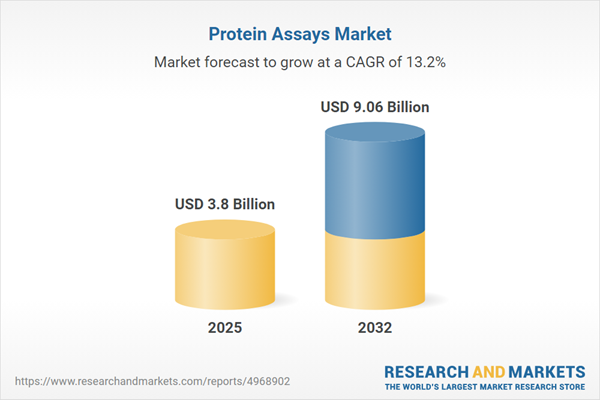Speak directly to the analyst to clarify any post sales queries you may have.
The protein assays market is rapidly advancing, shaped by technological breakthroughs, evolving regulatory frameworks, and rising demand for high-precision diagnostics and therapeutic solutions. Senior decision-makers require strategic insights to navigate the shifting landscape of protein quantification, detection, and analysis platforms.
Market Snapshot: Protein Assays Market Growth and Projections
The protein assays market grew from USD 3.36 billion in 2024 to USD 3.80 billion in 2025. It is projected to sustain a compound annual growth rate (CAGR) of 13.19%, reaching USD 9.06 billion by 2032. This robust growth is compelled by rapid technology integration, supply chain recalibrations, and a broadening spectrum of use cases across research, healthcare, and industry.
Scope & Segmentation of the Protein Assays Market
This comprehensive report offers an in-depth view of the protein assays market. Its findings are relevant for corporate strategists, R&D leaders, procurement executives, and investment analysts seeking granular knowledge across diverse market dimensions:
- Product Types: Assay kits and reagents, lateral flow solutions, microplate-based formats, instruments including LC-MS systems, microplate readers, SPR systems, and a broad range of services spanning contract research, maintenance and consulting, as well as training and support.
- Technologies: Enzyme-linked immunosorbent assays (ELISA), liquid chromatography-mass spectrometry (LC-MS) platforms such as Orbitrap, time-of-flight, triple quadrupole, surface plasmon resonance (SPR), and Western blotting.
- End Users: Academic and research institutes, contract research organizations, hospitals and diagnostic laboratories, pharmaceutical and biotechnology companies including large, small, and mid-sized pharmaceutical enterprises.
- Applications: Disease research and diagnostics (with sub-focus on genetic disorders, infectious diseases, oncology), drug discovery and development, environmental testing, food and beverage analysis.
- Regions: Americas (United States, Canada, Mexico, Latin America), Europe, Middle East & Africa (Western Europe markets, Middle East emerging hubs, major African economies), and Asia-Pacific (China, India, Japan, Australia, South Korea, and more).
- Company Coverage: Thermo Fisher Scientific Inc., Merck KGaA, Danaher Corporation, Bio-Rad Laboratories, Inc., Roche Holding AG, Agilent Technologies, Inc., PerkinElmer, Inc., Bio-Techne Corporation, Promega Corporation, Abcam plc.
Key Takeaways for Senior Decision-Makers
- Adoption of integrated digital and analytical solutions is enabling real-time biomolecular analysis and streamlined lab workflows, pivotal for maintaining competitive edge.
- Regulatory and tariff shifts are driving supply chain localization, increased emphasis on resilient sourcing, and innovation in reagent and consumable development.
- Growth in contract research and diagnostic services underscores demand for scalable, customizable assay solutions that address both high-throughput and specialized research requirements.
- Academic-pharma collaborations and technology vendor partnerships are accelerating assay validation, facilitating rapid response to emerging disease and R&D challenges.
- Point-of-care testing technologies, including enhanced lateral flow platforms, are broadening access to diagnostics in non-traditional and decentralized settings.
- Leadership in the protein assays space increasingly depends on intellectual property portfolios, robust R&D pipelines, and the ability to deliver modular, platform-agnostic solutions.
Impact of Tariffs and Supply Chain Changes
Recently implemented tariffs on imported reagents, specialized instruments, and key components have increased cost pressures and prompted extensive supply chain restructuring in the United States. Companies are responding by localizing supplier partnerships, dual sourcing, and boosting inventory buffers, while product innovation focuses on alternative reagent designs less vulnerable to trade disruptions. Service providers are also expanding compliance, logistics, and regulatory support to navigate evolving customs requirements and minimize research delays.
Methodology & Data Sources
This report utilizes a rigorous combination of primary interviews with industry experts, key opinion leaders, and stakeholders across numerous organizations. Secondary research integrates authoritative publications, regulatory filings, patent reviews, and cross-sectional market analysis. Triangulation and iterative validation ensure findings are robust, transparent, and unbiased.
Why This Report Matters for Protein Assays Market Leaders
- Delivers a nuanced market map that empowers strategic investments, risk assessments, and entry/expansion planning across global regions.
- Equips R&D and procurement leaders with deep insights on evolving product and technology ecosystems, supplier strategies, and compliance challenges.
- Supports the alignment of innovation pipelines with regional trends, regulatory priorities, and operational resilience strategies.
Conclusion
The protein assays market is evolving through collaborative innovation, complex supply chain adjustments, and cross-regional growth drivers. This analysis offers strategic direction for decision-makers to stay at the forefront of scientific progress, commercial opportunity, and operational efficiency.
Additional Product Information:
- Purchase of this report includes 1 year online access with quarterly updates.
- This report can be updated on request. Please contact our Customer Experience team using the Ask a Question widget on our website.
Table of Contents
3. Executive Summary
4. Market Overview
7. Cumulative Impact of Artificial Intelligence 2025
Companies Mentioned
The companies profiled in this Protein Assays market report include:- Thermo Fisher Scientific Inc.
- Merck KGaA
- Danaher Corporation
- Bio-Rad Laboratories, Inc.
- Roche Holding AG
- Agilent Technologies, Inc.
- PerkinElmer, Inc.
- Bio-Techne Corporation
- Promega Corporation
- Abcam plc
Table Information
| Report Attribute | Details |
|---|---|
| No. of Pages | 195 |
| Published | October 2025 |
| Forecast Period | 2025 - 2032 |
| Estimated Market Value ( USD | $ 3.8 Billion |
| Forecasted Market Value ( USD | $ 9.06 Billion |
| Compound Annual Growth Rate | 13.1% |
| Regions Covered | Global |
| No. of Companies Mentioned | 11 |









